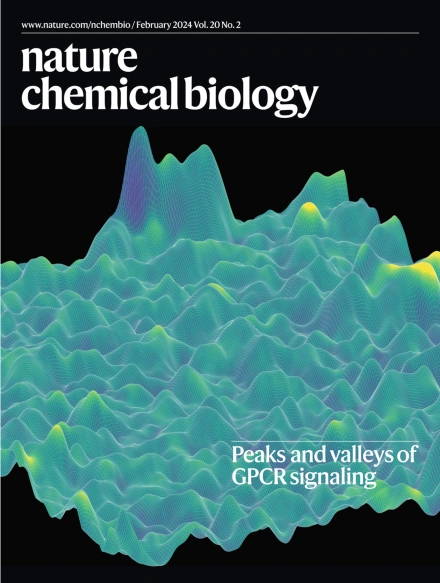干扰炎症
IF 13.7
1区 生物学
Q1 BIOCHEMISTRY & MOLECULAR BIOLOGY
引用次数: 0
摘要
BRCC36是一种Zn2+依赖的JAMM/MPN去泛素酶(DUB),是BRCC36异肽酶复合物(BRISC)的重要组成部分,其阻断k63连接的泛素化和I型干扰素受体(IFNAR1)的降解,以增强炎症信号。BRCC36的锌结合口袋与其他JAMM/MPN成员保守,这使得选择性靶向BRCC36变得困难。为了鉴定BRISC抑制剂,Chandler等人使用激酶抑制剂文库进行了生化筛选,检查了k63连接的泛素底物的变化。对潜在靶点的表征表明,JMS-175-2是一种brisc选择性抑制剂,可以阻断泛素链的切割,但不影响其他DUB成员。JMS-175-2化合物系列以非竞争性方式抑制BRISC,表明该化合物不太可能靶向催化所需的锌结合袋。低温电子显微镜和质谱分析表明,JMS-175-2具有分子胶的作用,促进了由16个亚基组成的BRISC二聚物的形成。随后,这些化合物被命名为BLUEs (BRISC分子胶)。结构和氢氘交换质谱分析显示,BLUEs与BRCC36和其他两个BRISC亚基(Abraxas2和BRCC45)接触,介导高阶二聚体的形成,通过阻断活性位点通路和阻止泛素结合来抑制活性。在正常细胞和来自自身免疫性疾病患者的细胞中,由于IFNAR1泛素化增加和IFNAR1细胞表面水平降低,BLUE治疗降低了IFNAR1信号传导和干扰素刺激的基因表达。虽然blue在体内减少炎症的功效需要进一步评估,但Chandler等人的研究揭示了一种选择性抑制DUB的独特策略。原始参考:Nat. Struct。摩尔。杂志。https://doi.org/10.1038/s41594 - 025 - 01517 - 5 (2025)本文章由计算机程序翻译,如有差异,请以英文原文为准。
JAMMing inflammation
求助全文
通过发布文献求助,成功后即可免费获取论文全文。
去求助
来源期刊

Nature chemical biology
生物-生化与分子生物学
CiteScore
23.90
自引率
1.40%
发文量
238
审稿时长
12 months
期刊介绍:
Nature Chemical Biology stands as an esteemed international monthly journal, offering a prominent platform for the chemical biology community to showcase top-tier original research and commentary. Operating at the crossroads of chemistry, biology, and related disciplines, chemical biology utilizes scientific ideas and approaches to comprehend and manipulate biological systems with molecular precision.
The journal embraces contributions from the growing community of chemical biologists, encompassing insights from chemists applying principles and tools to biological inquiries and biologists striving to comprehend and control molecular-level biological processes. We prioritize studies unveiling significant conceptual or practical advancements in areas where chemistry and biology intersect, emphasizing basic research, especially those reporting novel chemical or biological tools and offering profound molecular-level insights into underlying biological mechanisms.
Nature Chemical Biology also welcomes manuscripts describing applied molecular studies at the chemistry-biology interface due to the broad utility of chemical biology approaches in manipulating or engineering biological systems. Irrespective of scientific focus, we actively seek submissions that creatively blend chemistry and biology, particularly those providing substantial conceptual or methodological breakthroughs with the potential to open innovative research avenues. The journal maintains a robust and impartial review process, emphasizing thorough chemical and biological characterization.
 求助内容:
求助内容: 应助结果提醒方式:
应助结果提醒方式:


